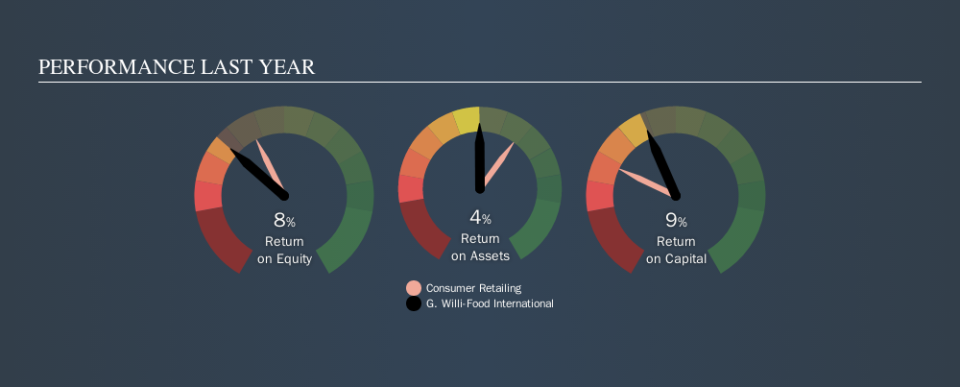Is G. Willi-Food International Ltd.’s (NASDAQ:WILC) Return On Capital Employed Any Good?

Today we'll evaluate G. Willi-Food International Ltd. (NASDAQ:WILC) to determine whether it could have potential as an investment idea. Specifically, we'll consider its Return On Capital Employed (ROCE), since that will give us an insight into how efficiently the business can generate profits from the capital it requires.
First of all, we'll work out how to calculate ROCE. Next, we'll compare it to others in its industry. And finally, we'll look at how its current liabilities are impacting its ROCE.
What is Return On Capital Employed (ROCE)?
ROCE is a metric for evaluating how much pre-tax income (in percentage terms) a company earns on the capital invested in its business. All else being equal, a better business will have a higher ROCE. Overall, it is a valuable metric that has its flaws. Author Edwin Whiting says to be careful when comparing the ROCE of different businesses, since 'No two businesses are exactly alike.
How Do You Calculate Return On Capital Employed?
The formula for calculating the return on capital employed is:
Return on Capital Employed = Earnings Before Interest and Tax (EBIT) ÷ (Total Assets - Current Liabilities)
Or for G. Willi-Food International:
0.092 = ₪43m ÷ (₪507m - ₪38m) (Based on the trailing twelve months to June 2019.)
Therefore, G. Willi-Food International has an ROCE of 9.2%.
See our latest analysis for G. Willi-Food International
Is G. Willi-Food International's ROCE Good?
When making comparisons between similar businesses, investors may find ROCE useful. It appears that G. Willi-Food International's ROCE is fairly close to the Consumer Retailing industry average of 9.7%. Separate from how G. Willi-Food International stacks up against its industry, its ROCE in absolute terms is mediocre; relative to the returns on government bonds. Readers may find more attractive investment prospects elsewhere.
In our analysis, G. Willi-Food International's ROCE appears to be 9.2%, compared to 3 years ago, when its ROCE was 4.3%. This makes us think about whether the company has been reinvesting shrewdly. You can see in the image below how G. Willi-Food International's ROCE compares to its industry. Click to see more on past growth.
When considering ROCE, bear in mind that it reflects the past and does not necessarily predict the future. ROCE can be deceptive for cyclical businesses, as returns can look incredible in boom times, and terribly low in downturns. ROCE is, after all, simply a snap shot of a single year. You can check if G. Willi-Food International has cyclical profits by looking at this free graph of past earnings, revenue and cash flow.
How G. Willi-Food International's Current Liabilities Impact Its ROCE
Current liabilities are short term bills and invoices that need to be paid in 12 months or less. The ROCE equation subtracts current liabilities from capital employed, so a company with a lot of current liabilities appears to have less capital employed, and a higher ROCE than otherwise. To counter this, investors can check if a company has high current liabilities relative to total assets.
G. Willi-Food International has total assets of ₪507m and current liabilities of ₪38m. As a result, its current liabilities are equal to approximately 7.4% of its total assets. G. Willi-Food International reports few current liabilities, which have a negligible impact on its unremarkable ROCE.
Our Take On G. Willi-Food International's ROCE
G. Willi-Food International looks like an ok business, but on this analysis it is not at the top of our buy list. Of course, you might also be able to find a better stock than G. Willi-Food International. So you may wish to see this free collection of other companies that have grown earnings strongly.
I will like G. Willi-Food International better if I see some big insider buys. While we wait, check out this free list of growing companies with considerable, recent, insider buying.
We aim to bring you long-term focused research analysis driven by fundamental data. Note that our analysis may not factor in the latest price-sensitive company announcements or qualitative material.
If you spot an error that warrants correction, please contact the editor at editorial-team@simplywallst.com. This article by Simply Wall St is general in nature. It does not constitute a recommendation to buy or sell any stock, and does not take account of your objectives, or your financial situation. Simply Wall St has no position in the stocks mentioned. Thank you for reading.

 Yahoo Movies
Yahoo Movies 

